During and after dinner, the kids had another surprise courtesy of Jane: a big box full of Chinese toys! Miranda and Sami picked up badminton right where they left off from school PE. Wang, our stellar bus driver, was a real pro, and loved teaching the kids. Everyone also enjoyed playing with Jane's Chinese yo-yos" which caused even the most serious adults in our group to regress with childlike glee.
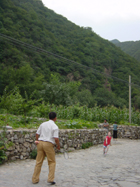 |
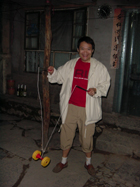 |
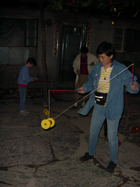 |
 |
With the kids happily at play, Sharon and I ventured off to hike along a mountain path with great views of the village below (that's how I got the panoramic shots that appeared at the beginning of this story).
It was a lovely time for a walk -- the sun was setting, it was getting cool, and the evening crickets were starting to sing. The path let us out at the far end of the village, and when I complained about my feet hurting, Sharon gladly jumped into action with this handy sedan chair!
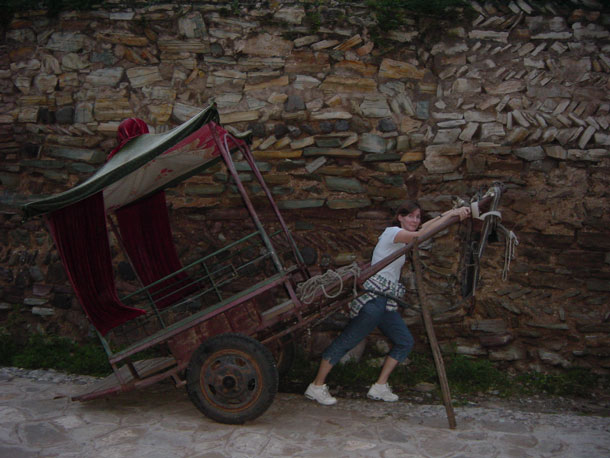
We could have played all night, but when the sun set, we discovered another fact of village life -- no streetlights!
We had heard there was to be a bonfire and dancing, and had no idea what to expect. Before it got too dark, Wang and I visited the hotel next door, which had a cache of fireworks! After loading up (who could resist fireworks that cost less than a pack of matches in the US), we took the kids out to the street for a happy half hour of throwing snapdragons at the rock walls.
In the US, the police would have arrived within minutes of hearing the rifle-like pops; here, in the birthplace of fireworks, no one cared. For a pyro like me, the night ahead was full of promise!
We strolled down the main drag to the village gate, where we found a large crowd of locals and visiting Chinese tourists milling around a crackling bonfire. Nearby loudspeakers blared Chinese pop songs so loudly that the girls covered their ears as they pranced around the fire.
Meanwhile, Wang, John and I broke out the fireworks! Soon the sky was filled with tracers that launched in quick succession from a small set of tubes we had bought, each ending with a loud bang and a different color. They weren't the most sophisticated rockets I'd seen, but they were loud and plentiful! |
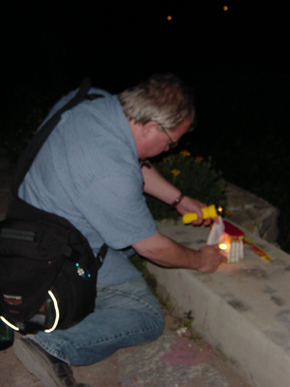 |
As soon as we ran out of fireworks, the locals cranked up the karaoke machine. Karaoke is a national obsession in China. Fortunately, most of the singers that evening were really quite good! My favorite singer was the woman pictured here. She stood about four feet tall, but she could have held her own with the biggest and loudest opera singers anywhere! She belonged to a tour group of disabled adults (I didn't want to ask why they were visting an old village with twisted stone paths and nothing much else to do). I don't know how much sightseeing they did, but they certainly drank a lot of beer, and practically monopolized the karoke! |
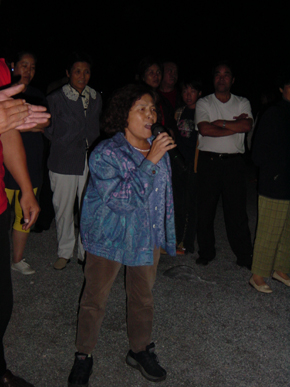 |
Much later than anyone expected, we tumbled into bed. The singing went on for a long time after we left.
Needless to say it was a strange night:
- curled up on a hard-as-stone kang
- covered with a quilt that had never seen the inside of a modern washing machine
- head resting on a pillow filled thousands of dried peas
- in a room with seven other restless sleepers
- serenaded by drunken, halting renditions of Chinese pop in the distance
Chalk it up to adventure of the highest - or maybe the lowest - order!
The roosters started crowing at first light, and the village woke quickly. First up was the 80+ year old resident grandmother of our farmhouse/hotell. Listening to her shuffling slowly across the courtyard on her way to the village toilet down the road helped me put my aches and fitful sleep into perspective.
By the time we had clambered out of bed and completed our necessities, the family who ran the hotel had pulled together a yummy farmer's breakfast of fresh corn cakes ( hard-as-rock local delicacy that we all bravely tried before moving on to more familiar fare), spring onion pancakes, hard-boiled eggs, hot rice congee, and marinated cucumbers.
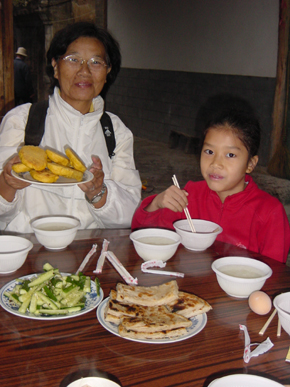 |
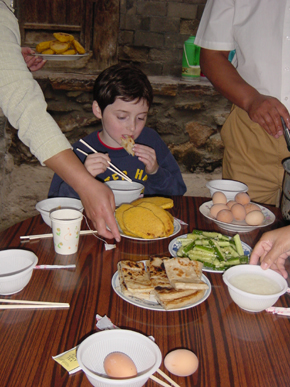 |
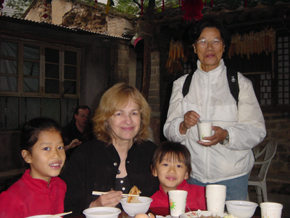 |
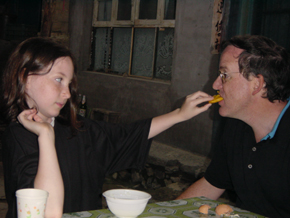 |
To be honest, I was craving a quick trip to Denny's, but since everyone else was digging in, I went along with the program. Of course, it was hard to resist when Miranda actually offered to feed me a corn cake!
It was a nostalgic moment, since 10 years ago that day Miranda had been born. We had all come a long way since then (literally and figuratively)! When I last lived in China (almost 20 years ago), I never imagined coming back with two daughters and a wife, and waking up in an old Chinese village together.
Miranda was a great sport, even though she clearly would have preferred to spend her birthday back in Palo Alto with her friends.
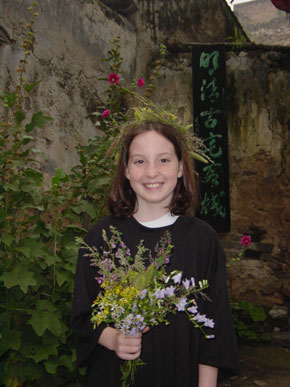 But
Miranda's mood brightened considerably when Michelle came back from an
early-morning walk through the surrounding hills with a gorgeous birthday
crown of wildflowers that she had picked and woven herself! She ceremonially
offered it to Miranda and we all spontaneously serenaded her with the
Chinese version of "Happy Birthday" (same tune, different words).
But
Miranda's mood brightened considerably when Michelle came back from an
early-morning walk through the surrounding hills with a gorgeous birthday
crown of wildflowers that she had picked and woven herself! She ceremonially
offered it to Miranda and we all spontaneously serenaded her with the
Chinese version of "Happy Birthday" (same tune, different words).
The crown was a wonderfully thoughtful gift, turning Miranda into the Birthday Princess. One of our farmer hosts said Miranda looked like a beautiful fairy!
Miranda's smile tells the whole story.
Thanks Michelle!!
After breakfast we ventured out to find the village bustling with activity as vendors from surrounding areas rolled into town hawking their wares. First along was a pickup truck filled with frozen fish from who knows where, all covered up with mounds of burlap sacks. I wanted to take a picture, but the stench was just too much. Once again a great reminder that it's best to only eat fish in China that you first saw swimming in a tank when you walked into a restaurant...
the next vendor cycled slowly into town, weighted down with two strange buckets balanced on the back wheel of his bicycle. When he stopped to uncover his wares, we were surprised to see huge blocks of fresh tofu!
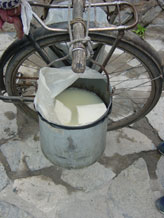 |
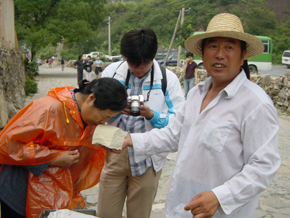 |
One vendor we could actually buy from was a local man who made a nice living roasting corn and selling it to tourists looking for authentic local taste treats. His roaster was half of a 55-gallon drum with an oversized wok on top. The corn couldn't have been fresher - the fields were literally across the street!
This type of roasted corn is a big delicacy in China, and a sure hit with our group!
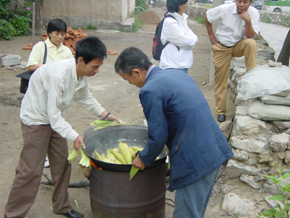 |
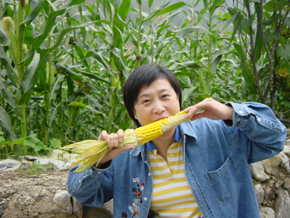 |
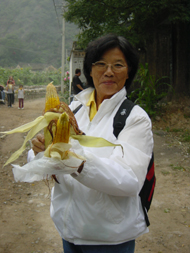 |
 |
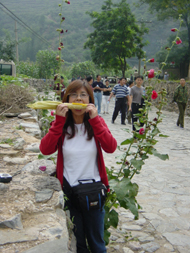 |
After finishing up the corn, we hopped back on the bus for the easy drive back to Beijing.
Our visit to Chuan Di Xia was a delightful trip back in time, and a great experience for the kids, all of whom were getting a bit antsy in anticipation of school starting. We have vowed to go anywhere Jane invites us with this great group!
On the way home we made plans for another weekend jaunt within an easy drive of Beijing. Stay tuned for details!
P.S. Right after we got back, the South China Morning Post ran the following article about Chuan Di Xia. We're SO trendy!
Monday, August 30, 2004
A village that time passed by
CHLOE LAI
Wang Xiulian has been the secretary-general of Chuandixia village for only two months, and already she has been bothered by a question: how to attract more tourists to the 500-year-old Ming dynasty mountain settlement, 90km west of metropolitan Beijing, yet protect its ancient courtyard homes (siheyuan) from the damage the travel business brings.
"We need experts to help [villagers do] the job, said Ms Wang, who administered a neighbouring village in her previous appointment. "We know there are many things we need to do to protect the originality and tranquillity of the village. But we don't know how it should be done.
"We know that if more and more tourists come, and most of them come here in their cars, we will have to restrict traffic and people flow. But what is the maximum capacity of the village? When should we impose the restriction? We have no answer to these questions. We need experts to sort this out for us."
The villagers, all belonging to the same Han family, are the 17th-generation descendants of the man who first built the settlement. As with other mainland villages, Chuandixia charges every visitor a 20-yuan entrance fee and this income pays for its administration, including staff salaries. The settlement is so important in the study of China's traditional architecture that it tops the nation's 12 most valuable historic villages, but most of its visitors are still Beijingers.
"Here is a good place for people to understand traditional Chinese architecture, how our ancestors built and lived in villages and houses," Ms Wang said.
About 70 courtyard homes have survived the passage of time. The smaller ones huddle at the bottom of the hill, while the larger homes meander up and down the terrain.
The early Han had a practical reason for building their homes along natural terrain, as it provided shelter to the villagers during floods.
The village's present location is not the original settlement site. A few years after 1519, when the Hans moved to the Taihangshan Valley, between their Shanxi homeland and the imperial city, there was a flood, and many villagers were killed. The survivors turned the old site into a graveyard and rebuilt their homes at the present location.
The siheyuan in Chuandixia are not exactly square. Their shapes changed with the slope of the land, and the villagers' ancestors obtained construction material from the surrounding countryside.
While most of the homes had the entrance built at the southeastern corner, so people on the street could not have a direct view of the courtyard, some homes have a wall built in front of their main entrance to achieve the same effect.
Visitors who wander through the alleys can gain an understanding of the village architecture and catch a glimpse of older cultural traditions, for example the restrictions imposed on young women in ancient China.
Some of the siheyuan were occupied by wealthy families and had an extra house behind the main residence on the hillside. This was the home of the village's unmarried daughters, shielded from the prying eyes of outsiders.
Chuandixia lies on an ancient trade route, the Jing-Xi post road that linked Beijing with Shanxi, Hebei and Inner Mongolia. Merchants used to eat and rest at the village's guesthouses before they embarked on the last part of their journey to Beijing. But the road became redundant with the construction of highways and railways in the 1950s, and Chuandixia's fortunes declined.
There is no record of how many people resided in the village during its golden age. The village administration's files show there were only 17 Han families, about 30 people, remaining in Chuandixia in the early 1990s. "Over the years, most of the people went to work in Beijing," Ms Wang said. "Those who stay relied on farming. Life was harsh."
But she said the migration proved a blessing in disguise. "As the villagers either moved out or were too poor to refurbish their homes, the village and the courtyard houses escaped the fate of alternation or demolition," Ms Wang said. Chuandixia is now one of the few surviving examples of a traditional Ming village and accompanying courtyard houses in the vicinity of Beijing.
Its buildings have become even more precious, since many courtyard houses in the capital were pulled down in the intense development of past decades. Those that survived demolition were altered significantly as Beijingers added extra structures to accommodate various household needs.
When architects and academics discovered Chuandixia in the early 1990s, they called it "a living museum". Then film directors set their movies in the village The latest was Feng Xiaogang's Cell Phone, which was shown on the mainland and in Hong Kong last year.
The intellectuals' and artists' interest in the village led its former village head, Han Mengliang, to realise that Chuandixia could resume its old business of serving travellers again. So villagers used the money earned from the movie industry to refurbish Chuandixia and improve tourism essentials such as sanitation and drainage.
In 1994, the Beijing Municipal Government recognised Chuandixia as a culturally and architecturally important village and prohibited unauthorised alternation and demolition of buildings. Last November, it topped the Ministry of Construction and the Bureau of Historical Relics' list of China's most historical and cultural villages. Many villagers have returned since Chuandixia sailed into the tourism business. Now, among the 32 Han families residing in Chuandixia, 30 of them have turned their ancestors' homes into guesthouses, providing accommodation and food to tourists. Of the other two families, one specialises in beekeeping, the other runs a little souvenir store.
A night in one of the guesthouses costs just 10 yuan, but Chuandixia's proximity to Beijing allows visitors to return home to the capital after an enjoyable walk in the living museum.
The fame of the village is growing. During this year's Labour Day holidays, 15,000 visitors travelled through the village. The number included a healthy contingent of foreigners, and the Chinese visitors were no longer confined to Beijingers.
"We really have to plan on how to protect the heritage," Ms Wang said. "We have to educate tourists that they should not take anything away from the village. We had one experience where some tourists took decorations from the houses they visited. If everyone did this, the village would be emptied."
Chuandixia is unable to prevent the unplanned construction of electricity poles and a water shortage, however. "We would like the government to build the electricity poles underground, so they won't upset the nostalgia," Ms Wang said.
"We also need more water. The entire village relies on a 300-metre well. We have to share this well with another village. The well dries up if we keep pumping for more than one hour."
--------------------------------------------------------------------------------
SCMP.com is the premier information resource on Greater China. With a
click, you will be able to access information on Business, Markets, Technology
and Property in the territory. Bookmark SCMP.com for more insightful and
timely updates on Hong Kong, China, Asia and the World. Voted the Best
Online newspaper outside the US and brought to you by the South China
Morning Post, Hong Kong's premier English language news source.